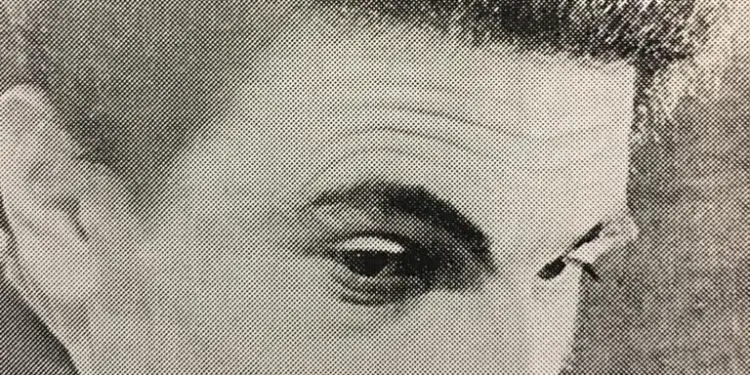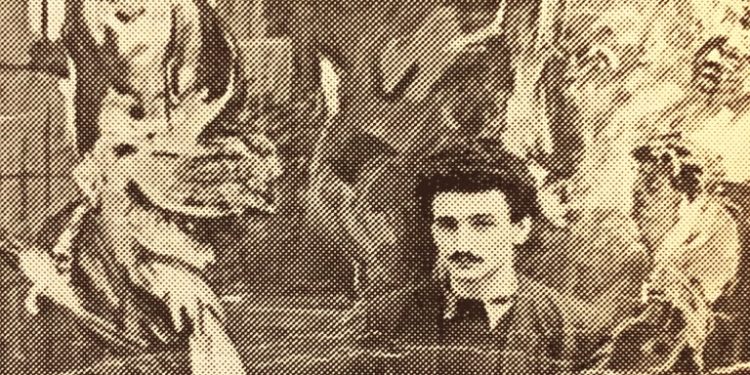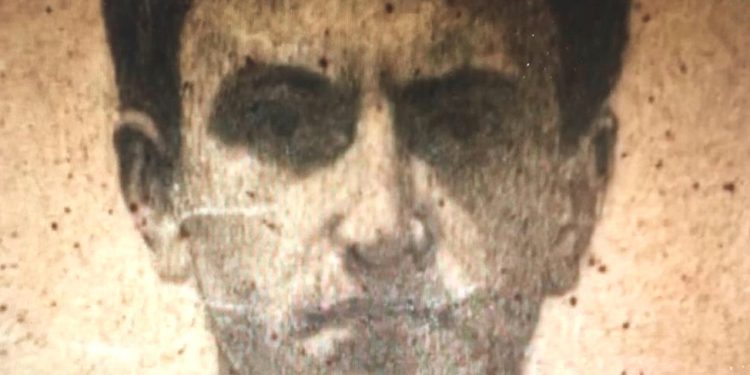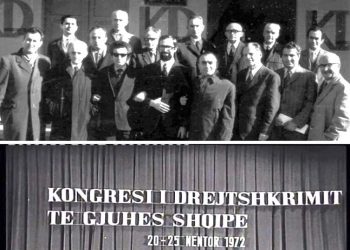Dashnor Kaloçi
Memorie.al publishes the unknown story of Jakup Keraj from the city of Shkodra with a Bosnian mother, who after receiving the first drawing lessons in his hometown from the Russian Viktori Puzanova and then from the master of the brush, Simon Rota, who considered him as one of the most talented students, he came to Tirana and graduated with high results from the Art High School “Jordan Misja” in 1952.
Jakup’s trip to the former Soviet Union to pursue higher studies at the Academy of Fine Arts “I.E. RJEPIN ”of Leningrad, where he was distinguished as one of the best students and when he was completing his diploma work, in his studio he went to see the famous Romanian painter, Corneliu Baba, and the reactor of that academy, as a sign of respect and appreciation , kept in his office a work of Jakup.
His return to Albania where he refused to replace a former lecturer at the Jordan Misja High School but went to his hometown, where for many years he was left to work as a teacher in several 8-year schools and where he taught Technical Drawing, and his work full of will and passion in the small studio where he often encountered the envy of colleagues and bosses from “above” who demanded changes to his paintings and he was forced to destroy them.
In the great constellation of Albanian artists of fine arts that have excelled in the genre of painting, a place of honor and special undoubtedly has the schools of Shkodra with the famous Zef Kolombi, Ndoc Martini, Kol Idromeno, Simon Rota, etc. In the footsteps of the tradition of this school, some other painters from that city follow, where we can mention the famous painter, Jakup Keraj, who passed away in the late ’80s. Who was Jakup Keraj, where did he study and what is his contribution to Albanian painting?
Jakup Keraj was born in the city of Shkodra on September 15, 1933, in a civic family from Shkodra. His father, Ahmeti, was known throughout Shkodra as a master of cuisine and he was able to open two restaurants, one in his hometown and one in Tirana, in the early 1940s, called “Bela-Venice”.
Russian student, Puzanova
From the elementary school benches, Jakupi showed great passion and inclination to draw, which caught the eye of his parents, especially his mother, Khadija, a noble cultured woman of Bosnian origin, who stayed for hours. whole looking at the little boy bent over with a pencil in his hand over the drawing sheets. Convinced of the gift of little Jakup, they sent him to take private lessons with a Russian lady, painter-restorer named, Viktor Puzanova, who at that time lived in the city of Shkodra, who cared for several years for that student who said that he is very different from the others. Afterwards, Jakupi became one of the students of the famous painter and craftsman from Shkodra, Simon Rota, who saw in him a talent that promised a lot. Of all the students that the painter from Shkodra, Simon Rota, had, Jakupi loved and appreciated him the most, distinguishing him separately from the others. Regarding this, in his memoirs, Professor Simoni wrote, among other things: “Jakupi is a very charming boy and dressed with great taste. He was waiting for me outside the window for me to finish the lesson and come to get the drawing patterns. I was often surprised, because Jakupi immediately swallowed them and came and returned them to me along with the work he had done. Years later, when Jakupi grew up and we became a colleague at the Pedagogical School of Shkodra, every time he saw me, he would take his hands out of his pockets and tell me; Thank you professor. I was amazed by his behavior and one day I asked him: Jakup, why do you say thank you?! He replied: All my life, every time he met me, he would say that word to me. “He was grateful to me for the painting lessons I had once given him.” According to some testimonies from the city of Shkodra, the master Rota loved and appreciated his student so much that as a sign of remembrance he had given him two or three drawings and a picture of him in the landscape. In 1948-’49, after Jakupi had taken several years of drawing lessons with the master Simon Rota, he came to Tirana and enrolled in the Art High School “Jordan Misja”, which he graduated with high results. Almost all the time that Jakupi studied in Lice, he was under the patronage of the famous painter, Professor Nexhmedin Zajmi, who also took care of two of Jakupi’s friends from Shkodra, Danish Jukniu and Angjelin Dodmasej.
Student at the Leningrad Academy
After graduating with honors from the Art High School in 1952, Jakupi gained the right to study to go and attend classes at the Academy of Fine Arts “I.E. RJEPIN” of Leningrad. In that academy at that time studied other Albanian students (who years later would become great masters of Albanian painting and sculpture), such as Guri Madhi, Vilson Kilica, Shaban Hadëri, Kristaq Rama, Rafael Dembo, etc. Regarding the period that Jakupi studied in the former Soviet Union, his brother, the famous composer, poet and painter, Ruzhi Keraj, shows that he often spoke longingly about that time, remembering with nostalgia all the friends of the school and in in particular, Korça, Rafael Dembo. Who during a teaching practice in the Caucasus, fell off a cliff and remained crippled for life. During the five years he studied at the Liningrad Academy, Jakupi was considered one of the most talented students and his name remained in the memories of the professors for a long time. When a few years later, there in that academy, Sali Shijaku was studying, the professors called him Jakup. At that time one of Jakup’s best works was placed in the office of the Rector of the Academy, which was a privilege of few students since the establishment of that academy. At the end of his studies, when Jakupi was working on the painting “Liberation of Women from Turkish Prison”, which had a diploma work, the great Romanian painter Corneliu Baba entered his studio, which was also a privilege of a few talented students. In those few minutes that the great Romanian painter stayed in the studio of the Albanian student, the communication between them was very friendly at the beginning. This faded when the great craftsman Baba addressed Jakup telling him to continue the painting even further. At that moment, Jakupi put his signature below the painting and addressed him: “Professor, for me this is over”. From this period of studies in Leningrad, in the fund of Jakup Keraj, there are some good works such as wonderful nudes, portraits and sketches which were the only baggage that he returned from the Soviet Union.
In Shkodra, Technical Drawing teacher
After graduating and graduating with honors from the Academy “I.E. RJEPIN” of Leningrad (St. Petersburg), he returned to Albania in 1956.
At that time, one of the leaders of the Ministry of Education called Jakupi to his office and offered him an alternative, so that he could replace a well-known painter in the Lyceum of Tirana, or else go to work in Shkodra. Jakupi never agreed to go to Lice and replace his former lecturer and asked to be appointed in his hometown of Shkodra. After that, the directors of Education in the Executive Committee of Shkodra at that time, appointed Jakupi as a teacher of Technical Drawing in the gymnasium “29 Nëntori”, Jakupi was given a small studio, measuring 2 m. me 2 m. squares. In that small environment, he accomplished some of his best work, such as the one entitled “Male Heroes.” While Jakupi was working on this painting, which has been praised by critics as an artistically accomplished work, to look at it from a distance, he often went out of it. Despite the very difficult conditions in which Jakup’s family was at that time (all six brothers went on to graduate from high schools, three of whom were artists), their father, Ahmeti, with great sacrifices was able to build a studio there. in his house. After building that studio which had much better conditions than where he had worked before, he started working with more pleasure and staying there for long hours leaning on the easels. Thus, he worked on the painting “Assembly of Lezha”, “Winter March”, and some portraits and paintings that are today found in the Art Gallery of Shkodra and Tirana. Regarding the painting “Assembly of Lezha”, Jakupi’s brother, Ruzhdiu recalls: “When Jakupi was working on that painting, he was very upset by the words of some malicious people that he had all his life around. But fortunately, in those days his two friends went to his studio, the famous actors and directors from Shkodra, Lec Bushati (who forgave the voice of Skanderbeg, the Russian Akaki Khorava) and Prengë Lëkunda. After they saw the painting, they cheered with one voice: This is a miracle, a masterpiece. The superlative evaluation that the two well-known actors and directors made of that picture, warmed Jakupi somewhat, in that coldness, where the sick selfishness of some of his colleagues had introduced him “.
Portraitist and master of color
After Jakupi worked for several years as a teacher of Technical Drawing at the gymnasium “29 Nëntori” he was appointed as a teacher at the Pedagogical School “Shejnaze Juka”, where he continued to work with passion and throughout his career as a painter, he successfully delivered all the techniques and genres of painting, such as: landscape, portrait, compositions, etc. Many of his colleagues appreciate Jakupi, saying that among other things, he is distinguished from other painters, as a master of drawing and color, and in particular in the realization of portraits, some of which are considered masterpieces of Albanian painting. For this genre he was also evaluated by the professors of the Academy “I.E. RJEPIN” of Leningrad where he graduated. Although at that time for Albanian painters the portrait was considered a heresy and many of his colleagues avoided it, Jakupi realized some of them. For example. that of his close friend, the famous painter Danish Jukniu, the portrait of his brother, Ruzhdi, etc. His works of this period are also, “Dedë Gjo Luli”, “Hodo Sokoli”, “Girl under the Vine”, and many other portraits. Vladimir Myrtezai, one of the painters of a generation later than Jakupi, who also graduated from the Shkodra drawing school, recalls: “Jakupi himself was an impressionist by nature. He did all the work with one breath, not parting for a moment, without feeling tired. He was a rejectionist, and there have been several instances where, from remarks received from critics, he has completely ruined his work, for which he had worked so hard. Where the critics demanded that the picture continue, for Jakup it was over, and vice versa, when she called it finished, he continued it. Jakupi never returned to his works for the second time “, Myrtezai remembers, for the well-known painter and anti-conformist from Shkodra. In addition to the genre of portrait where Jakupi shone with all his talent, he also left some very accomplished works in landscapes such as “Shkodra”, “Rozafat Castle”, “Buna”, “Snow in Shkodra” etc. In the late ’80s, after working as a teacher in two high schools, Jakup was removed and appointed to an 8-year school where he worked for several years, to be sent later to the Music “Preng Jakova”.
Thethi, eternal inspiration
One of Jakup’s inspirations was the natural beauties of Theth, where he constantly went and marveled at his landscape. By the mid-1980s when he fell ill, even though he knew he had not much life left, in conversations with his family and friends, he never mentioned death. He was a man of high morals and never fainted from the disease that had gripped him. In this regard, brother Ruzhdiu recalls: “At that time, although in poor health, he was very vital. Just in that position where the legs no longer respond, lying on the blanket, he painted the last painting in Theth. There he met and talked at length with his good friend, prof. “Vehbi Bala, and after that conversation, the two said goodbye to each other, and left so that they would never see each other again.”
Jakup’s death, Kilica reflects in the picture
By the end of 1987, Jakup’s health had deteriorated to the point where he could not cope with the illness. That late fall, despite the bad weather, his funeral in the city of Shkodra was magnificent. One of his friends and colleagues, the famous painter, Wilson Kilica, impressed by that funeral, as if to always remember his living friend and colleague, reflected him in a large painting. This painting is probably one of the most unique in the entire history of Albanian painting. Shortly after Jakup’s death, the local government in the city of Shkodra took away his studio, which he had difficulty fixing, and turned it into a house. Thus, apart from some of his paintings, which are found in the Art Gallery of Tirana and Shkodra, the rest of Jakup’s fund is located in the fund of the Keraj family in Shkodra. Even after Jakup’s death, the painting in the Keraj family could still live, because in addition to his brother, Ruzhdiu (famous poet and composer) who has opened several solo exhibitions in the city of Laç and Tirana, in the footsteps of Jakup, walk the two children of his: daughter Albana and son Petriti, who in the ’90s graduated from the Academy of Fine Arts in Tirana for painting and sculpture. / Memorie.al

























